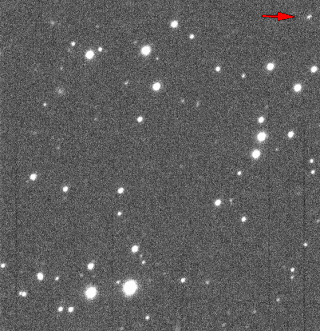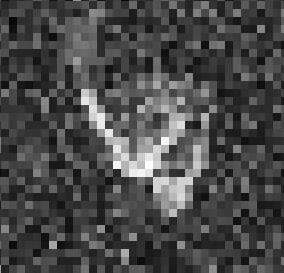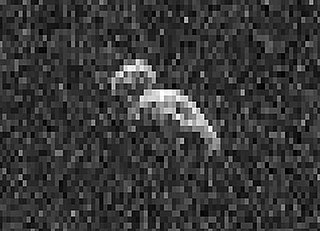Related Research Articles
2202 Pele, provisional designation 1972 RA, is an eccentric asteroid and near-Earth object of the Amor group, approximately 1–2 kilometers in diameter.
(179806) 2002 TD66 (also written 2002 TD66) is a sub-kilometer asteroid, classified as near-Earth object of the Apollo group. It was discovered on 5 October 2002, by the LINEAR project at Lincoln Laboratory's ETS in Socorro, New Mexico. It was announced on 7 October 2002 and appeared later that day on the JPL current risk page.

(480808) 1994 XL1 is a sub-kilometer asteroid, classified as near-Earth object and potentially hazardous asteroid of the Aten group, approximately 200 meters (700 feet) in diameter. It was discovered on 6 December 1994, by Scottish–Australian astronomer Robert McNaught at Siding Spring Observatory in Australia. It was one of the first asteroids discovered to have a semi-major axis less than Venus.
4401 Aditi is an eccentric, stony asteroid, classified as a near-Earth object and Amor asteroid, approximately 1.8 kilometers in diameter. It was discovered on 14 October 1985 by American astronomer Carolyn Shoemaker at Palomar Observatory in California, and later named after the Hindu goddess Aditi.
2608 Seneca, provisional designation 1978 DA, is a stony asteroid and sub-kilometer near-Earth object of the Amor group, approximately 0.9 kilometers in diameter. It was discovered on 17 February 1978, by German astronomer Hans-Emil Schuster at ESO's La Silla Observatory in northern Chile, and named after Roman philosopher Seneca.
(6037) 1988 EG is an eccentric, stony asteroid, classified as near-Earth object and potentially hazardous asteroid. It belongs to the group of Apollo asteroids and measures approximately half a kilometer in diameter. It was discovered by American astronomer Jeff T. Alu at the U.S. Palomar Observatory, California, on 12 March 1988.

2010 TD54 is a tiny asteroid and fast rotator, classified as a near-Earth object of the Apollo group, approximately 5 meters in diameter. It was first observed by the Mount Lemmon Survey in October 2010, when the asteroid crossed through the Earth-moon system and had a close encounter with Earth.
(467336) 2002 LT38, is a sub-kilometer asteroid and suspected tumbler, classified as a near-Earth object and potentially hazardous asteroid of the Aten group, approximately 240 meters (790 ft) in diameter. It was discovered on 12 June 2002, by astronomers of the Lincoln Near-Earth Asteroid Research at the Lincoln Laboratory's Experimental Test Site near Socorro, New Mexico, in the United States.
(416151) 2002 RQ25 is a carbonaceous asteroid of the Apollo group, classified as near-Earth object and potentially hazardous asteroid, approximately 0.2 kilometers in diameter. It was discovered on 3 September 2002, by the Campo Imperatore Near-Earth Object Survey (CINEOS) at the Italian Campo Imperatore Observatory, located in the Abruzzo region, east of Rome.

(511002) 2013 MZ5, provisional designation 2013 MZ5, is a sub-kilometer asteroid, classified as a near-Earth object of the Amor group, estimated to measure approximately 300 meters (1,000 feet) in diameter. It was discovered on 18 June 2013, by astronomers with the Pan-STARRS survey at Haleakala Observatory on the island of Maui, Hawaii, in the United States. It was the 10,000th near-Earth object ever discovered.

(192642) 1999 RD32, provisional designation: 1999 RD32, is an asteroid and suspected contact binary on an eccentric orbit, classified as a large near-Earth object and potentially hazardous asteroid of the Apollo group, approximately 5 kilometers (3 miles) in diameter. It was discovered on 8 September 1999, at a magnitude of 18, by astronomers of the LINEAR program using its 1-meter telescope at the Lincoln Laboratory's Experimental Test Site near Socorro, New Mexico, United States. The asteroid is likely of carbonaceous composition and has a rotation period of 17.08 hours.
(374158) 2004 UL is a sub-kilometer asteroid on an outstandingly eccentric orbit, classified as near-Earth object and potentially hazardous asteroid of the Apollo group. The object is known for having the second-smallest perihelion of any known asteroid, after (137924) 2000 BD19.

(388188) 2006 DP14, provisional designation 2006 DP14, is a sub-kilometer sized, peanut-shaped asteroid on a highly eccentric orbit, classified as near-Earth object and potentially hazardous asteroid of the Apollo group. This contact binary was discovered on 23 February 2006, by astronomers of the LINEAR program at the Lincoln Laboratory's Experimental Test Site near Socorro, New Mexico, in the United States. On 10 February 2014, it passed 6.25 lunar distances from Earth. The asteroid is approximately 400 meters in diameter and has a rotation period of 5.77 hours.
(391211) 2006 HZ51 is a bright, sub-kilometer asteroid on an eccentric orbit, classified as a near-Earth object and a potentially hazardous asteroid of the Amor group. It was discovered on 27 April 2006, by astronomers of the Catalina Sky Survey conducted at Mount Lemmon Observatory, Arizona, United States. During preliminary observations, it was thought to have a small chance of impacting Earth in 2008. The asteroid measures approximately half a kilometer in diameter and has an exceptionally high albedo.
(456938) 2007 YV56, provisional designation 2007 YV56, is a sub-kilometer asteroid on an eccentric orbit, classified as a near-Earth object and potentially hazardous asteroid of the Apollo group, approximately 190–360 meters (620–1,200 ft) in diameter. It was discovered on 31 December 2007, by astronomers of the Catalina Sky Survey conducted at the Catalina Station in Arizona, United States.
2001 AV43 is a very small, monolithic asteroid and fast rotator, classified as a near-Earth object of the Apollo group, approximately 30 meters (98 feet) in diameter. It was first observed on 5 January 2001, by astronomers of the LINEAR program at Lincoln Laboratory's Experimental Test Site near Socorro, New Mexico, in the United States. The presumed S-type asteroid has a rotation period of only 10 minutes. It has an exceptionally low MOID of 0.66 lunar distance (LD) and will approach Earth at 0.81 LD on 11 November 2029.

(671294) 2014 JO25 is a near-Earth asteroid. It was discovered in May 2014 by astronomers at the Catalina Sky Survey near Tucson, Arizona - a project of NASA's NEO (Near Earth Object) Observations Program in collaboration with the University of Arizona.
2013 GM3 is a micro-asteroid, classified as near-Earth object of the Aten group, approximately 20 meters in diameter. It was first observed on 3 April 2013, by astronomers of the Mount Lemmon Survey conducted at the Mount Lemmon Observatory near Tucson, Arizona, United States.

2018 DV1 is a micro-asteroid, classified as a near-Earth object of the Aten group, approximately 6–12 meters (20–40 feet) in diameter. It was first observed on 26 February 2018, by astronomers of the Mount Lemmon Survey at Mount Lemmon Observatory, Arizona, five days prior to its sub-lunar close encounter with Earth at less than 0.3 lunar distance.
(85182) 1991 AQ is a stony asteroid on a highly eccentric orbit, classified as near-Earth object and potentially hazardous asteroid of the Apollo group, approximately 1.1 kilometers in diameter. It was discovered on 14 January 1991, by American astronomer Eleanor Helin at the Palomar Observatory in California. Based on its brightness variation of 0.69 magnitude, this Q-type asteroid is likely elongated. It belongs to the small group of potentially hazardous asteroids larger than one kilometer.
References
- 1 2 3 4 5 "JPL Small-Body Database Browser: 6491 (1991 OA)" (2015-07-25 last obs.). Jet Propulsion Laboratory . Retrieved 26 May 2017.
- 1 2 3 4 5 "LCDB Data for (6491)". Asteroid Lightcurve Database (LCDB). Retrieved 24 July 2016.
- 1 2 3 Erikson, A.; Mottola, S.; Lagerros, J. S. V.; Lindgren, M.; Piironen, J.; Oja, T.; et al. (October 2000). "The Near-Earth Objects Follow-up Program. III. 32 Lightcurves for 12 Objects from 1992 and 1995". Icarus. 147 (2): 487–497. Bibcode:2000Icar..147..487E. doi:10.1006/icar.2000.6457 . Retrieved 1 January 2016.
- 1 2 3 "6491 (1991 OA)". Minor Planet Center. Retrieved 24 July 2016.
- ↑ "JPL Close-Approach Data: 6491 (1991 OA)" . Retrieved 24 March 2012.
2011-09-29 last obs